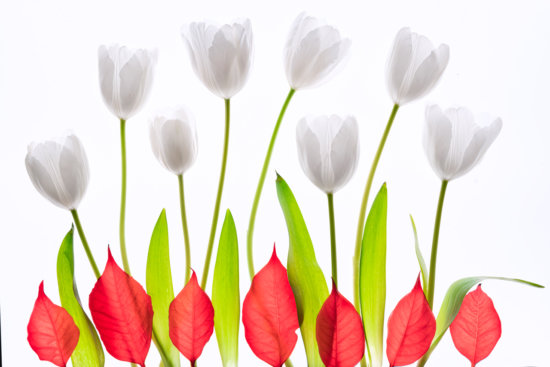Getting started with Progressive Flower Photography Composition
Photography does not have to be expensive to be enjoyable. We can scratch the itch without spending thousands of dollars to trek to Yellowstone, Yosemite, or Iceland. These are certainly fulfilling and adrenaline-pumping experiences, but thankfully I get the same rush when I drive around my neighborhood looking for magnolia blossoms with clippers in my hand! YES, I am a different kind of thrill seeker. With a full-time job and kids, I can only take one or two big trips a year for my landscape photography. But, to keep my passion alive, I need my quota of time spent behind the camera. My solution is to bring a little piece of nature home that I spend hours, sometimes days, photographing. What piece of nature is this? Flower Photography.
Today I will walk you through what went on in my head during a shoot with a bouquet of about 15 white tulips I bought at Kroger’s for 13 dollars. Welcome to Padma’s World!!
Step 1: Start with a Simple in Flower Photo
I did not overwhelm myself with all 15 at once. I selected one flower which I examined carefully to see whether it was free of blemishes. With my macro lens, I then photographed that one flower 15 different ways. Generally, I change lenses, POV, lighting, and backgrounds – different colors, textures, and depths can all be used. The possibilities are endless with flower photos.
Honestly, this exercise never gets old for me. It forces me to work the subject from every possible angle. If you really want to learn composition, I would suggest this tip to everyone. For this particular shoot, I decided to keep it simple and left my macro lens on for the duration. Here are a couple that I liked from that one single tulip.
Step 2: Experiment with your flower photography composition
Now it’s time to add another tulip. And another and then another to experiments with progressive flower photography composition. The best way to learn about flower arrangement is to keep trying. There are infinite ways to arrange a set of flowers. I am inspired enough to spend 4 to 6 hours straight photographing them in dozens of arrangements.
Be mindful of how long the flowers are out of water, however. If left too long, they will start to look withered and will not photograph well. So treat them delicately and try to have water handy to put them into when not in use.
My flower photography compositions are inspired by Japanese Ikebana and Western floral styles. Ikebana is a living, ancient art form in which blooms, stems, leaves, and branches are arranged in an intentional, almost sculpturesque ways. The goal of an Ikebanist is to draw out the most beautiful forms of these plants. The results are minimalistic, yet touching.
There is a certain philosophical, meditative element to it, that in Japanese culture is steeped in flower symbolism. Western style flower arrangements emphasize abundance, often placing flowers to maximize lushness, sometimes in crowded groupings. While both styles appeal to me immensely in their own ways, I try to marry them for flower photography compositions. Even my 15 tulip arrangements, the most full in this series, are simple in composition.
Step 3: Add color to your Flower Photography
In the beginning, work with a single color scheme for your flower photography compositions – this will be easier to edit in post-processing. For example, if you are working with a pink and red color scheme, the camera settings would have to be slightly different from pink to red.
This may result in complicated post processing to get your exposure and colors just the way you want them. So unless you have intermediate Photoshop Layers & Masks post processing skills, it will be hard to combine the exposures to get to the final version of the image you want. Even after all these years, I still try to work with one type of flower at a time. Simplicity is the best way in this case.
Step 4: Finishing Touches
After all is said and done, when I had photographed all my tulips and they started inevitably fading, I gathered up all the petals that had fallen to the ground and made a heart out of them. How did I do it? I cut a template out of a cardboard box and used that as my guide, ensuring smooth, even borders for my shape. It reminds me of coloring books. Really, I try to stay inside the lines! And sometimes, if I do not have enough petals to make a heart, I cheat a little by taking two different shots and merge them in Photoshop using layers and masks.
Landscape photographers love to dream of their next big adventure but, as I’ve demonstrated with these lovely tulips, we don’t have to go to great lengths to get great photos. Personally, I can get just as lost in a bouquet of flowers as at a trail-side waterfall.
And the opportunity to look closely, experiment, and slow down will help you become more familiar with your lenses, camera settings, lighting setup, color theory, and post-processing in Photoshop. All for just $13 or less! So give flower photography a shot if you’re looking for inspiration. You may just find your inspiration at your local grocery store, garden, or florist.


















